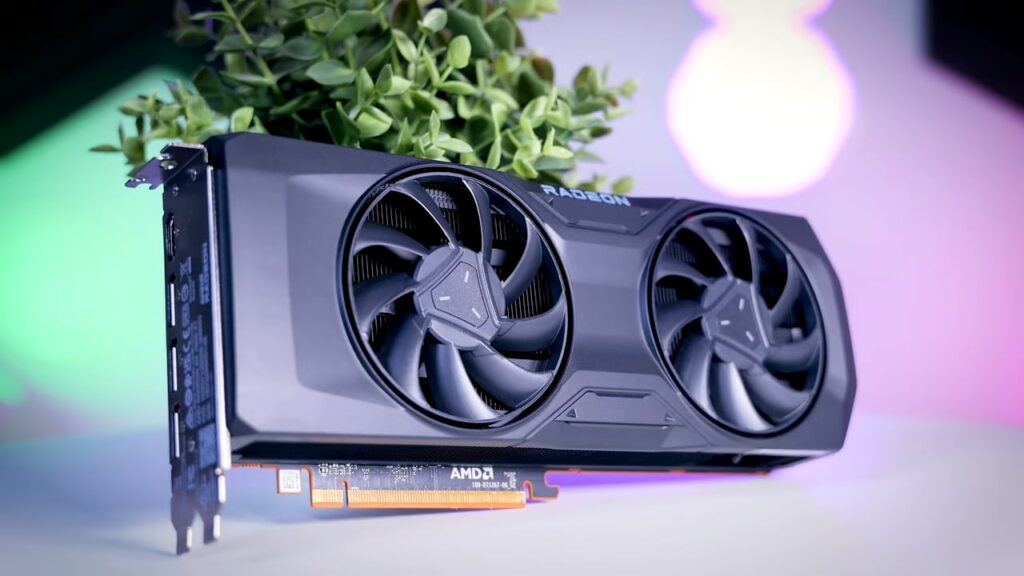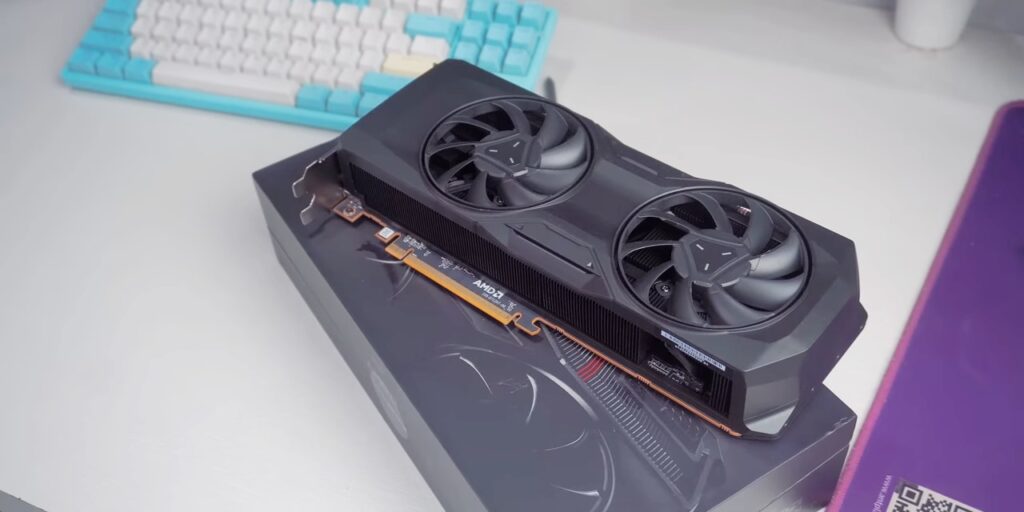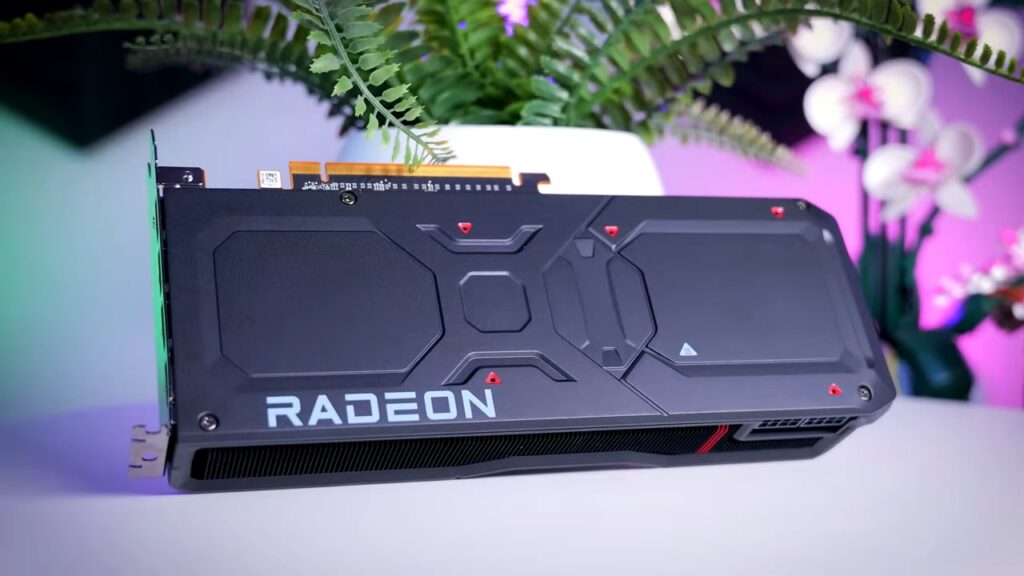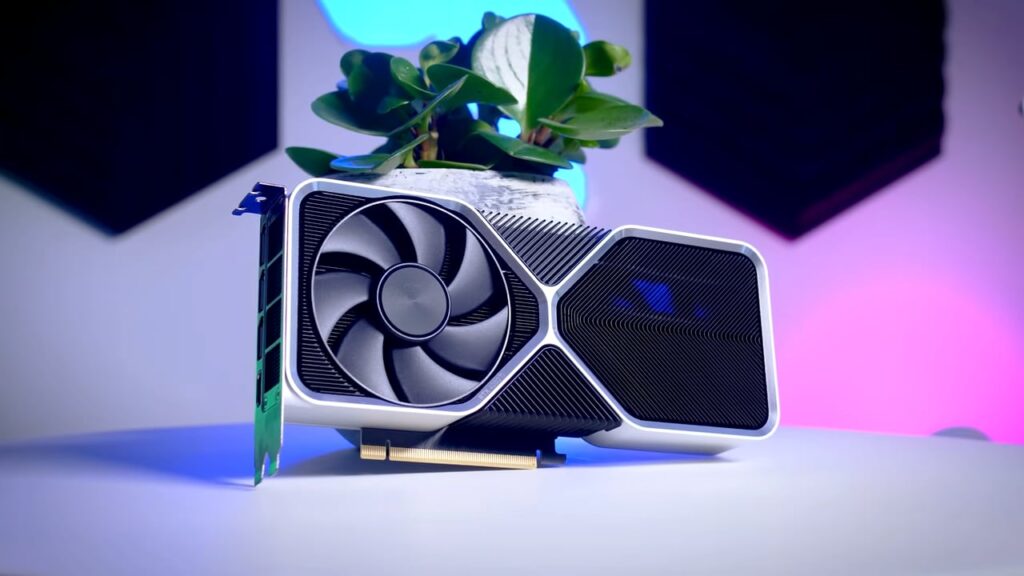


AMD has once again sparked interest in the gaming world with the release of its next-generation graphics cards in the performance class. The Radeon RX 7800 XT and RX 7700 XT are ready to close the performance gap between the enthusiast-class RX 7900 series, designed for maximum 4K gaming, and the mainstream RX 7600, designed for 1080p games. Both of these new cards are optimised for the 1440p resolution, which is becoming increasingly popular, as evidenced by the Steam Hardware Survey. In this post, we’ll go over the specifications of these two strong GPUs, as well as their architecture and usefulness in the competitive gaming market.

The Radeon RX 7800 XT embodies AMD’s dedication to providing cutting-edge gaming experiences. It leverages the powerful 5 nm EUV foundry node where it matters most—the compute units and graphics rendering machinery—to harness the power of the RDNA3 graphics architecture. This card’s use of the new Navi 32 silicon, a chiplet-based GPU comparable to the one powering the RX 7900 series, is a noteworthy feature. AMD’s smart usage of chiplets guarantees that the advanced 5 nm foundry node is fully utilised.
The Navi 32 chiplet method separates components that benefit the most from the new node, such as compute units, from those that do not benefit as much, such as Infinity Cache memory and GDDR6 memory controllers. These less-sensitive components are manufactured on the earlier 6 nm node as memory cache dies (MCDs). The RX 7800 XT has four of these MCDs, each of which houses a 16 MB section of the chip’s 64 MB Infinity Cache as well as a 64-bit wide piece of the GPU’s 256-bit GDDR6 memory interface.
This architecture enables the RX 7800 XT to fully utilise the capabilities of Navi 32, allowing all 60 RDNA3 compute units to work together for a remarkable configuration that includes 120 AI Accelerators, 60 Ray Accelerators, 240 TMUs, 96 ROPs, and a 256-bit wide GDDR6 memory interface with a generous 16 GB of memory. The GPU runs at an astounding 2124 MHz Game clock and 2430 MHz boost, while the RAM runs at a blistering 19.5 Gbps, resulting in an incredible 624 GB/s memory bandwidth.
The Radeon RX 7700 XT, which is similarly based on Navi 32 architecture, is a somewhat smaller version of the RX 7800 XT. It has 3,456 stream processors, 108 AI accelerators, 54 Ray accelerators, 216 TMUs, and 96 ROPs with 54 out of 60 compute units activated. The RX 7700 XT has three of four MCDs activated, as well as 48 MB of Infinity Cache and a 192-bit GDDR6 memory interface with 12 GB of memory. The GPU has faster clocks, with game clocks reaching 2171 MHz and boost clocks reaching 2544 MHz. The memory operates at 18 Gbps and provides a reasonable 432 GB/s of memory bandwidth.

The RDNA3 graphics architecture that powers the RX 7800 XT delivers a slew of new features. The use of dual-issue rate compute units, enhanced idle SIMD resource utilisation, and support for additional math formats all lead to a 17% increase in IPC over RDNA2 compute units. This results in a significant improvement in overall performance. Furthermore, the shader engines work at faster clock speeds than the previous generation, substantially improving performance.
The 2nd generation Ray Accelerator is a notable addition to RDNA3. It is intended to give a 50% generational boost in ray intersection performance and represents a significant jump in ray tracing capabilities, an area in which AMD is determined to compete effectively.
The GPU’s front-end, which operates at a 10-15% higher clock speed than the shader engines, is a notable development in RDNA3. This enhancement improves efficiency and overall performance. The RX 7800 XT is an enthusiast-class graphics card, with a total board power of 263 W and compatibility for two regular 8-pin PCIe power connectors.
The RDNA3 Dual-Compute Unit (CU) is an important architectural breakthrough of the RDNA3 period. The RDNA3 CU offers multi-precision capability with 64 stream processors per CU, operating as 1x SIMD64 or 2x SIMD32 units. Because of the new AI Matrix Accelerator, the Vector Unit that houses these SIMD units can function as a SIMD execution mechanism or a Matrix execution unit. This enhancement improves matrix multiplication performance by 2.7x when compared to normal SIMD execution. The addition of support for the Bfloat16 instruction set and SIMD8 execution improves the GPU’s AI capabilities even further.
Ray tracing performance improves significantly with the RDNA3 architecture. The improved Ray Accelerator, together with hardware-level optimisations such as early sub-tree culling and specialised box sorting modes, adds to a ray tracing speed increase of 80% over the previous iteration. Furthermore, enhancements in geometry- and pixel-pipes, as well as the new multi-draw indirect accelerator (MDIA), improve rendering capabilities. The core arrangement increases rasterized performance each clock by 50%.
The Navi 32’s Display Engine has been greatly upgraded by AMD, including native support for DisplayPort 2.1. This allows for output at up to 8K resolution with refresh rates of up to 165 Hz or 4K with refresh rates of up to 480 Hz over a single cable. Furthermore, the improved FSR 2 algorithm adds 8K support, letting players to enjoy AAA titles at playable frame rates on 8K monitors. The RX 7800/7700 XT features two full-size DP 2.1 connectors, an HDMI 2.1b port, and a USB-C connector with DP 1.2 passthrough.
AMD’s multimedia expertise extends to the Navi 32 silicon’s AV1 encode and decode capabilities. This provides compatibility with the most recent media standards, which improves video streaming and content creation experiences.

The debut of FidelityFX Super Resolution 3 (FSR 3) and Fluid Motion Frames (FMF) is one of the most anticipated announcements. FSR 3 intends to compete with NVIDIA’s DLSS 3 Frame Generation technology by tripling frame speeds by creating alternate frames without going through the entire graphics rendering pipeline. FMF, a crucial element of FSR 3, implements frame interpolation technology similar to that seen in consumer televisions.
FMF distinguishes itself from DLSS 3 Frame Generation by utilising the graphics rendering process and leveraging the GPU’s main SIMD mechanism via asynchronous compute. This method offers more compatibility by supporting any recent DirectX 12 GPU that supports async computation. AMD’s FSR 3 FMF is simple to implement into games, and the firm has already announced 12 games that will use this technology, with more on the way.
AMD’s HYPR-RX is an exciting new function that has been implemented into the AMD Software control centre. It makes performance boosting easier with a one-click solution that works with any DirectX 11 or DirectX 12 game. HYPR-RX combines Radeon Boost, Radeon AntiLag+, and Radeon Super Resolution, applying these features dynamically to running games as needed. Radeon Boost improves performance by altering render resolution, but Radeon Super Resolution boosts frame rates through upscaling. Radeon AntiLag+ reduces latency, resulting in a more fluid gaming experience. AMD intends to incorporate FMF into the HYPR-RX feature set in the future.
| Graphics Card | RX 7800 XT | RX 7700 XT | RX 6800 XT | RX 6700 XT | RTX 4070 | RTX 4060 Ti 8GB / 16GB |
|---|---|---|---|---|---|---|
| Architecture | Navi 32 | Navi 32 | Navi 21 | Navi 22 | AD104 | AD106 |
| Process Technology | TSMC N5 + N6 | TSMC N5 + N6 | TSMC N7 | TSMC N7 | TSMC 4N | TSMC 4N |
| Transistors (Billion) | 28.1 + 4x 2.05 | 28.1 + 3x 2.05 | 26.8 | 17.2 | 32 | 22.9 |
| Die size (Sqmm2) | 200 + 150 | 200 + 113 (150) | 519 | 336 | 294.5 | 187.8 |
| CUs or SMs | 60 | 54 | 72 | 40 | 46 | 34 |
| GPU Cores (Shaders) | 3840 | 3456 | 4608 | 2560 | 5888 | 4352 |
| AI / Tensor Cores | 120 | 108 | N/A | N/A | 184 | 136 |
| Ray Tracing “Cores” | 60 | 54 | 72 | 40 | 46 | 34 |
| Boost Clock (MHz) | 2430 | 2544 | 2250 | 2581 | 2475 | 2535 |
| VRAM Speed (Gbps) | 19.5 | 18 | 16 | 16 | 21 | 18 |
| VRAM (GB) | 16 | 12 | 16 | 12 | 12 | 8 / 16 |
| VRAM Bus Width | 256 | 192 | 256 | 192 | 192 | 128 |
| Infinity / L2 Cache | 64 | 48 | 128 | 96 | 36 | 32 |
| ROPs | 96 | 96 | 128 | 64 | 64 | 48 |
| TMUs | 240 | 216 | 288 | 160 | 184 | 136 |
| TFLOPS FP32 (Boost) | 37.3 | 35.2 | 20.7 | 13.2 | 29.1 | 22.1 |
| TFLOPS FP16 (FP8) | 74.6 | 70.4 | 41.4 | 26.4 | 233 (466) | 177 (353) |
| Bandwidth / Effective (GBps) | 624 / 2708 | 432 / 1995 | 512 / 1664 | 384 / 1278 | 504 / ? | 288 / 554 |
| TBP/TGP (Watts) | 263 | 245 | 300 | 230 | 200 | 160 |
| Launch Date | Sep 2023 | Sep 2023 | Nov 2020 | Mar 2021 | Apr 2023 | May / July 2023 |
| Launch Price | $499 | $449 | $649 | $479 | $599 | $399 / $499 |
| Online Price | $500 | $450 | $500 | $320 | $590 | $374 |
AMD’s RX 7800 XT pricing approach is aggressive and competitive. With a price tag of $500, it promotes itself as a direct competition to the GeForce RTX 4070 while saving $100. AMD included the space opera RPG Starfield with the RX 7800 XT, making it an appealing alternative for gamers.

The reference design card is designed in the same style as the reference RX 7900 XT. The RX 7800 XT reference card features a triple-slot design with two axial-flow fans and a dense aluminium fin-stack heatsink, demonstrating AMD’s commitment to providing strong cooling and performance. It is available with minimum rebranding through AMD’s own web store as well as the company’s board partners.
AMD reaffirms its commitment to delivering outstanding gaming experiences with the release of the Radeon RX 7800 XT and RX 7700 XT. The RX 7800 XT, which is priced competitively at $500, offers itself as a formidable contender to the GeForce RTX 4070, providing great performance while saving $100. The addition of Starfield broadens its appeal.
The RX 7700 XT, a slightly scaled-down version of its sibling, offers gamers an outstanding 1440p gaming alternative. AMD’s latest solutions are likely to make ripples in the gaming sector, with an emphasis on delivering robust performance and affordable pricing.
Gamers around the world can look forward to an exciting future with powerful GPUs that redefine performance gaming as AMD continues to innovate and extend its gaming technology portfolio. Stay tuned for more updates and game integrations as AMD continues to push gaming technology forward.